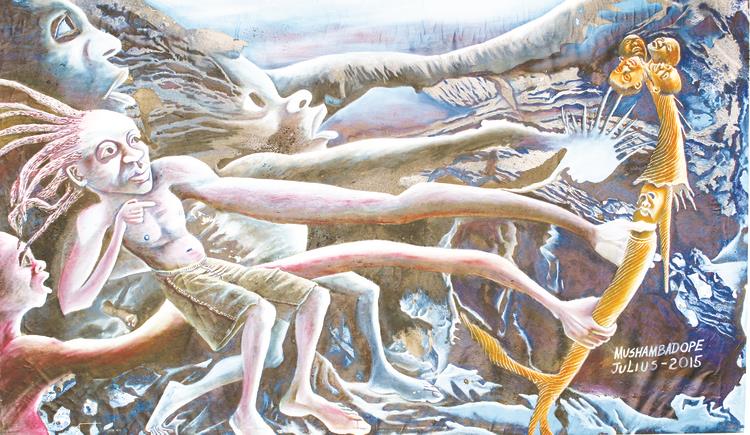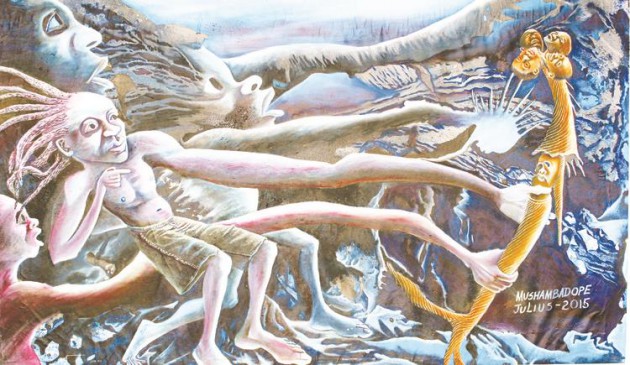The National Gallery hosts three exhibitions

 At the Gallery
At the Gallery
THE National Gallery of Zimbabwe will be hosting a series of cutting edge exhibitions, as the institution prepares for its 60th anniversary celebrations set for July 21, 2017.
The exhibitions are Familiar histories: An Unstoppable Force in Contemporary Art Discourse which is already up and running,Narrative Vessels:
An exhibition of artefacts from the Permanent Collection and Unpacking the Vision: From Rembrandt to Mubayi which will open on Friday the 21st of July.
Currently on show is the Familiar Histories: An Unstoppable Force in Contemporary Art Discourse,curated by the Chief Curator and Deputy Director at the National Gallery of Zimbabwe Mr Raphael Chikukwa. The exhibition brings together artists who are obsessed with found objects and showcases how they have transformed these objects into amazing works of art.
It interrogates current debates in the social, cultural, religious, economic and historical spheres. These are the very issues which inspire artists in their practice and creative processes.
Artists in the show areAntony Bumhira, Masimba Hwati, Mukudzeishe Muzondo, Nox Chimbetete, Tafadzwa Gwetai,Wallen Mapondera, Julius Mushambadope, Terrence Musekiwa, the late Keston Beaton, Victor Nyakauru and Munyaradzi Mazarire.
Works by Wallen Mapondera explore the urban landscape in African cities that are confronted by water shortages. His choice of material using cardboard box is exceptional and his body of work brings to attention the issue of water shortages around the continent.
This body of work comes at a time when many other cities in Africa are facing water shortages and these include; Cape Town, Nairobi, Dar Salaam, Harare, Nairobi, Lagos and Kampala.
Mapondera’s sculptural pieces are powerful as they show the other side of the artist who is known for his works on canvas.
Munyaradzi Mazarire’s work takes the audience into living rooms of people. His use of found objects and his exploration of perspective are very powerful. In his work Mazarire’s fascination with space and perspective, presenting illusions and subliminal construction is what Mazarire is known for.
The young artist Terrence Musekiwa breaks the divide between traditional Zimbabwean stone sculpture and contemporary material. His work is different from his fathers’ who is one of the established Zimbabwean Sculptors. Terrence’s visual language is very powerful in its own way and it taps into the current urban landscape of our cities.
Nox Chimbetete’s portraits of different characters in different hairstyles bring to the audience the discussions of human hair and the identity that we carry.
It also brings in another discussion of our natural hair and natural beauty that we as Africans have always ignored. Chimbetete’s works bring out how human hair has been popularised in the African continent and asks us questions about our identity.
Mukudzeishe Muzondo’s work also questions the identity crisis that Africa is faced with today and brings in the faith that the African people have as they confront the challenges that they face.
On the other hand, Julius Mushambadope’s paintings question the role of a woman in our society and also explore our own culture that has and continues to be distorted in this global village.
Tafadzwa Gwetai’s work is primarily an interrogation into the existence of mankind in close relation to the contemporary times. He explores identity through a scientific approach where he engages elements from science, mathematics and even biology and transforms those ideas into his own interpretations of life.
Anthony Bumhira takes Zimbabweans back to the Dhoyilisi era where most women would go across the Limpopo River to sell madhoiri / crochet materials in search of a better living for their families as cross border traders.
His works also show the role that women play in this world as they struggle to raise their children. These stories are familiar to so many Zimbabweans and artists continue to tap into these realities. Victor Nyakauru`s fascination with animals can be seen in this exhibition as his sculpture of Musoro we Mombe/Cow head is part of the show.
Musoro we Mombe/ Cow head is symbolic of power in our Zimbabwean culture as seen at any traditional ceremony; it is the head of the family that is given the cow’s head.
MasimbaHwati’s works are from our permanent collection and his choice of material also demonstrates that he is one artist who is obsessed with found objects. The late Keston Beaton is one of the masters of found objects in the 90’s.
Meanwhile the Narrative Vessels – An exhibition of artefacts from the Permanent collection curated by the Conservation and Collections Manager at the National Gallery, Mrs Lilian Chaonwa, traces a narrative that begins with the domestic containers and progressively moves away from the private intimate object to an art that spills into the public domain.
Vessels that have a past, a present and an infinitely variable future, these pieces provide both realities and fictions. This relationship between the functional and the non-functional, the disposable and the precious, is one theme that emerges in the works featured in this exhibition. Several pots and baskets and other vessels transform into powerful stories although their original purpose was often only a humble record of family events and traditional gatherings.
This exhibition therefore, seeks to revive a Zimbabwean art that merges traditional practice with contemporary styles and techniques to produce unique objects, standing not just as utilitarian objects but as credible art pieces, as well as valuable sources of information about a society. The skills and innovation demonstrated in making these objects has seen them elevated from the realm of craft to be recognised as art.
These objects are not mere art but they are art objects of mediation. The “Narrative Vessels” invites the viewers to exercise their imaginations and interactive participation, in order to create new meanings from the items in the show.
Remember every Friday of the month of July 2017 entrance into the Gallery is free. Come into the Gallery and enjoy these cutting edge exhibitions on show and many other public programmes that the Gallery has to offer.
Another exhibition set to be the highlight of the 60th anniversary celebration, Unpacking the Vision: From Rembrandt to Mubayi is an exhibition that taps into the Gallery’s Permanent Collection from the past to the present as part of our 60th anniversary. Despite its vision to collect, preserve and promote the country’s visual culture, the Gallery holds a diverse collection that includes traditional artefacts from around the African continent and old European Masters paintings.
The Collection which encompasses paintings, sculptures, drawings, graphic art, posters, prints, ceramics, photographs, new media art and the new Zimbabwe Pavilion collection is here for both local and international audience to enjoy and value.
From Rembrandt to Mubayi is an exhibition which showcases a few selected works to mark the Gallery’s 60th Anniversary celebrations. This is also to celebrate those that have contributed to the existence of the National Gallery of Zimbabwe and these include, past directors, past board members, past members of staff, audience, and artists and the present director, Friends of the Gallery, Board Members and staff.
The exhibition will open and run for a day that is the 21st of July when the Gallery will be having its birthday celebration.









Comments